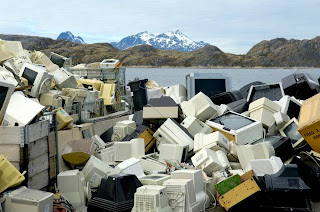Importance of Re-extraction of rare earth metals from e-waste.
Why is there a need for the re-extraction of rare earth metals from e-waste?
 |
The first reason depends on the material
type; rare earth metals are embedded in low concentrations in rocks. They are
not that rare, but they are called rare earth metals because they are difficult
to isolate.
Another reason is that; 20 to 50 million metric tons of e-waste are disposed of worldwide every year. India generates about 2 million tonnes (MT) of e-waste annually. Cell phones and other electronic items contain high amounts of precious metals like gold or silver.
One
tonne of mobile phones has as much as 340 grams of gold, 3.5 kilograms of
silver, 140 grams of palladium, and 130 kilograms of copper. Americans dump
phones containing over $60 million in gold/silver every year. Only 12.5% of
e-waste is currently recycled.
For example,
1) Neodymium is used to make powerful
magnets used in loudspeakers and computer hard drives to be smaller and more
efficient.
2) Praseodymium is used to create strong
metals for use in aircraft engines. Praseodymium is also a particular glass
component used to make visors to protect welders and glassmakers.
3) Cerium is used in catalytic converters
in cars, enabling them to run at high temperatures and playing a crucial role
in the chemical reactions in the converter. Lanthanum and cerium are also used
in the process of refining crude oil.
Now that we have seen why rare earth metal
extraction is essential, let's see some methods of re-extraction of rare earth
metals from e-waste.
Pyro-metallurgical Process:
E-waste is melted with several flux components as slag formatives in the pyrometallurgical process. Here the molten material which contains the valuable metals comes in contact with the molten metal pool in which the valuable metals in the molten materials accumulate. The accumulated molten metal is called collector metal. Then, further treatment on the collector metal is done to separate and purify the different metals present in the molten metal pool.
Hydrometallurgical Process:
In the pyro-metallurgical process, the e-waste is melted. But in the Hydrometallurgical process, the valuable metals in the e-waste are first leached with acid or alkali solutions. Then they are concentrated by methods like cementation, precipitation, and solvent extraction.
Bio Leaching:
Apart from the above two methods, this
process uses bacterial means for extraction. Here bacterial leaching of metals
in the e-waste is used. This method's most commonly used bacteria are
acidophi-lus and chemolithotrophic microbial consortia of: Acidithiobacillus
ferrooxidans, Acidithiobacillus thiooxidans, Leptospirillum ferrooxidans and
heterotrophs.
References: http://epe.pwr.wroc.pl/2013/1-2013/Willner_1-2013.pdf
https://www.jchps.com/specialissues/Special%20issue3/33%20jchps%20si3%20addn%20kavitha%20147-149.pdf
NOTE:-
This blog is meant for Educational Purpose
only .We do not own any Copyrights related to images and information , all the
rights goes to their respective owners . The sole purpose of this blog is to
Educate, Inspire, Empower and to create awareness in the viewers. The usage is
non-commercial(Not For Profit) and we do not make any money from it.
Blog Credits: Avishkar Avinash Kale ,112011054
(SY, Metallurgy) (team Meta Monday)
FOLLOW US ON:-
INSTAGRAM :
https://bit.ly/coep_blogs_insta
LINKEDIN:
https://bit.ly/coep_blogs_linkedIn
YOUTUBE:
https://bit.ly/Coep_blogs_YouTube


Comments
Post a Comment